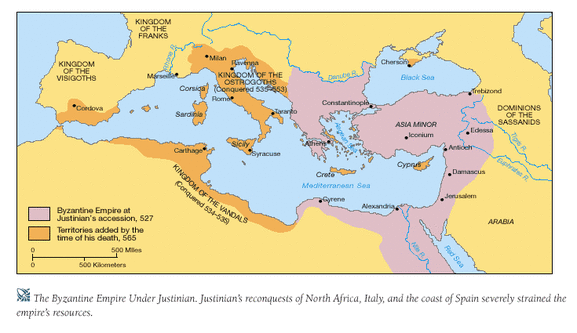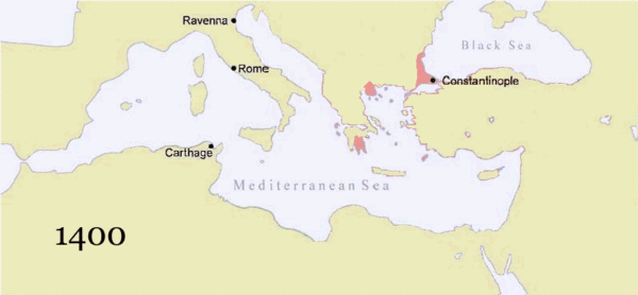Eastern Europe: Byzantine Empire
Culture

Christianity was a major influence on the culture of the Byzantine empire. However, despite its defining impact on Byzantine culture, Christianity caused divisions between the eastern and western regions of the empire.
There were a number of differences between Christianity in the Byzantine empire and in Western Europe. One of the differences emerged in Church leadership. the Byzantine emperor was not a priest, but he still controlled church affairs and appointed the patriarch in Constantinople. The Byzantine Christians rejected the pope and his authority over all Christians. Furthermore, unlike priests in Western Europe, Byzantine clergy kept their right to marry, and the official language of the Byzantine church was Greek, not Latin. Also, the chief Byzantine holiday was Easter, honored as the day Jesus rose from the dead, whereas Western Christians emphasized Christmas, the birthday of Jesus.
Because of these various differences, the two branches of Christianity at this time moved farther and farther apart. The split between the two was mainly triggered by the dispute over the use of icons, or holy images. Byzantine Christians used to pray to images of Christ, the Virgin Mary, and the saints, but when a Byzantine emperor outlawed the veneration and worship of icons in the 700's, violent battles erupted. The pope excommunicated the emperor which led to greater resentment against the pope.
In 1054, a string of other controversies and disputes provoked a schism, or permanent split, between the Byzantine (Eastern) Greek Orthodox and the Roman Catholic churches. The pope and the patriarch excommunicated each other. After this, the two treated each other as rivals and contact was very distant and limited.
There were a number of differences between Christianity in the Byzantine empire and in Western Europe. One of the differences emerged in Church leadership. the Byzantine emperor was not a priest, but he still controlled church affairs and appointed the patriarch in Constantinople. The Byzantine Christians rejected the pope and his authority over all Christians. Furthermore, unlike priests in Western Europe, Byzantine clergy kept their right to marry, and the official language of the Byzantine church was Greek, not Latin. Also, the chief Byzantine holiday was Easter, honored as the day Jesus rose from the dead, whereas Western Christians emphasized Christmas, the birthday of Jesus.
Because of these various differences, the two branches of Christianity at this time moved farther and farther apart. The split between the two was mainly triggered by the dispute over the use of icons, or holy images. Byzantine Christians used to pray to images of Christ, the Virgin Mary, and the saints, but when a Byzantine emperor outlawed the veneration and worship of icons in the 700's, violent battles erupted. The pope excommunicated the emperor which led to greater resentment against the pope.
In 1054, a string of other controversies and disputes provoked a schism, or permanent split, between the Byzantine (Eastern) Greek Orthodox and the Roman Catholic churches. The pope and the patriarch excommunicated each other. After this, the two treated each other as rivals and contact was very distant and limited.
Economics - Trade
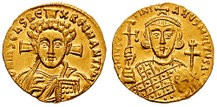
Trade was one of the major driving forces of the Byzantine economy. Constantinople was located on important east-west and north-south trade routes, making it a center of international trade. Grain and silk were two of the most important commodities of the Byzantine empire. Commodities are items that are bought and then sold, especially unprocessed materials. Grain was an important source of food and held a very high demand. Silk was used by the Byzantines both as a form of payment and diplomacy. Raw silk was imported from China and created into fine cloth that sold for high prices. In time, the production and sale of silk became an imperial monopoly. Many other commodities were traded in Constantinople and throughout the Byzantine empire: oil, wine, salt fish, meat, vegetables, other alimentary products, salt, timber, and wax. Other items of trade were: ceramics, linen, wooden cloth, and luxury items such as silks, perfumes, and spices. The most important items of export were textiles. The Byzantines conducted trade with Egypt, Bulgaria, the West, and Venice.
Politics
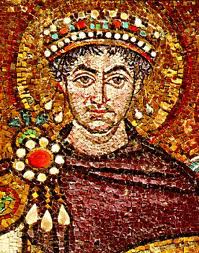
The Byzantine Empire reached its peak under the rule of the emperor Justinian who ruled from 527-565. Justinian ruled as an autocrat, or sole ruler with complete authority. He used the law to unite and revive the empire under his control. Justinian also had power over the church. He was even deemed Christ's co-ruler on Earth. A Byzantine official wrote, "The emperor is equal to all men in the nature of his body, but in the authority of his rank he is similar to God who rules all." Unlike the feudal monarchs of Western Europe, Justinian combined both political power and spiritual authority in his rule. During his reign, he was aided by his wife, Theodora. She was a clever politician and she served as adviser and co-ruler to Justinian. Justinian's most lasting contribution to society was his reform of the law. He set up a commission to collect, revise, and organize all the laws of ancient Rome. These laws were called, Corpus Juris Civilis, or "Body of Civil Law." Today it is commonly known as Justinian's code.
The Byzantine Empire began to decline after the schism between the Byzantine and Western European Christians. There were power struggles over succession and constant civil wars that greatly weakened the strength of the empire. Powerful local lords gained control of large areas. As the empire declined, the enemies of the Byzantines advanced to take advantage of the Byzantines' weakness. The Normans conquered Southern Italy and the Seljuk Turks advanced across Asia Minor.
To help fight the Seljuk Turks, the Byzantine emperor called for western help in the 1090's. The result of this was the First Crusade. In later crusades, however, rivalry over trade sparked violence between the Byzantines and the Venetians.
In 1453, Ottoman forces surrounded Constantinople. After a two month siege, the Ottomans crossed the broken walls. The Byzantine emperor surrendered and Constantinople fell to the Ottoman ruler, Muhammad II. Constantinople was renamed Istanbul and became the capital of the Ottoman empire. Istanbul soon emerged as a great center of Muslim culture.
The Byzantine Empire began to decline after the schism between the Byzantine and Western European Christians. There were power struggles over succession and constant civil wars that greatly weakened the strength of the empire. Powerful local lords gained control of large areas. As the empire declined, the enemies of the Byzantines advanced to take advantage of the Byzantines' weakness. The Normans conquered Southern Italy and the Seljuk Turks advanced across Asia Minor.
To help fight the Seljuk Turks, the Byzantine emperor called for western help in the 1090's. The result of this was the First Crusade. In later crusades, however, rivalry over trade sparked violence between the Byzantines and the Venetians.
In 1453, Ottoman forces surrounded Constantinople. After a two month siege, the Ottomans crossed the broken walls. The Byzantine emperor surrendered and Constantinople fell to the Ottoman ruler, Muhammad II. Constantinople was renamed Istanbul and became the capital of the Ottoman empire. Istanbul soon emerged as a great center of Muslim culture.
Innovations
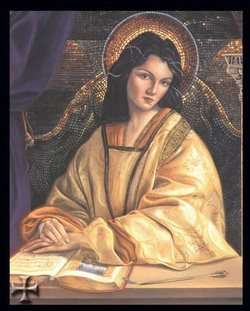
The Byzantine Empire made unique contributions to art, especially religious art and architecture. Icons evoked the presence of God and allowed viewers to feel connections with the sacred figures. Beautiful mosaics captured scenes from the Bible and brought them to life. In architecture, the palaces, churches, and buildings of the Byzantines combined the styles of the Greeks, Persians, Romans, and others from the Middle East.
Byzantines scholars and historians also published books and works of literature, especially in the field of history. Anna Comnena is considered to be the western world's first important female historian. She wrote the Alexiad, in which she analyzed the reign of her father.
Byzantines scholars and historians also published books and works of literature, especially in the field of history. Anna Comnena is considered to be the western world's first important female historian. She wrote the Alexiad, in which she analyzed the reign of her father.
